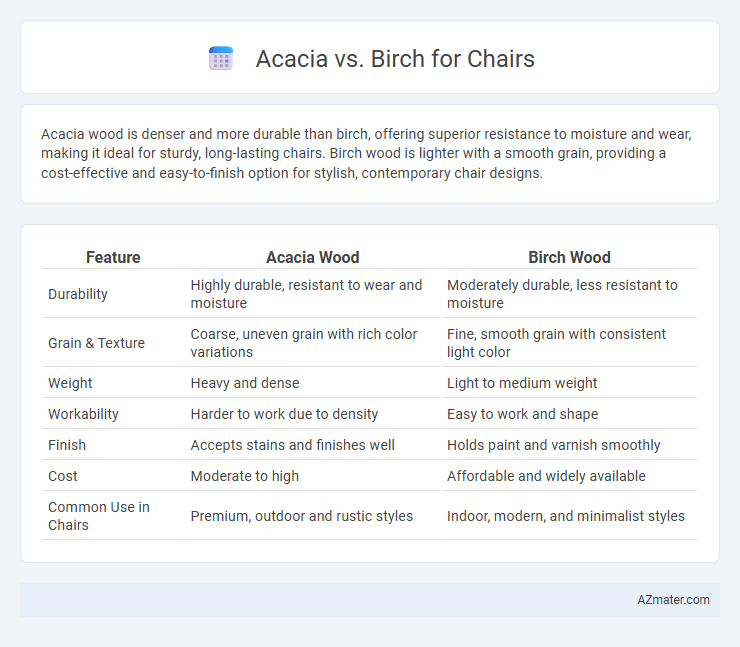Acacia wood is denser and more durable than birch, offering superior resistance to moisture and wear, making it ideal for sturdy, long-lasting chairs. Birch wood is lighter with a smooth grain, providing a cost-effective and easy-to-finish option for stylish, contemporary chair designs.
Table of Comparison
| Feature | Acacia Wood | Birch Wood |
|---|---|---|
| Durability | Highly durable, resistant to wear and moisture | Moderately durable, less resistant to moisture |
| Grain & Texture | Coarse, uneven grain with rich color variations | Fine, smooth grain with consistent light color |
| Weight | Heavy and dense | Light to medium weight |
| Workability | Harder to work due to density | Easy to work and shape |
| Finish | Accepts stains and finishes well | Holds paint and varnish smoothly |
| Cost | Moderate to high | Affordable and widely available |
| Common Use in Chairs | Premium, outdoor and rustic styles | Indoor, modern, and minimalist styles |
Introduction: Acacia vs Birch for Chair Making
Acacia and birch are popular wood choices for chair making due to their durability and aesthetic appeal. Acacia is known for its rich, warm tones and natural resistance to moisture, making it ideal for both indoor and outdoor furniture. Birch offers a lighter color palette with a fine, uniform grain, providing a smooth finish and excellent strength for chair frames.
Wood Characteristics: Acacia and Birch Compared
Acacia wood is dense, durable, and highly resistant to water and wear, making it ideal for long-lasting, sturdy chairs with rich, warm tones and natural grain patterns. Birch wood, known for its fine, even texture and pale color, offers a smooth finish and moderate durability, providing a lighter aesthetic suitable for modern or Scandinavian-style chairs. Both woods provide stability, but Acacia's higher natural oil content gives it superior resistance to decay compared to the more porous Birch.
Durability and Strength: Which Wood Lasts Longer?
Acacia wood is known for its high durability and resistance to wear, making it an excellent choice for chair construction due to its dense grain and natural hardness. Birch wood offers good strength and a smooth finish, but it is generally less dense and more prone to dents and scratches compared to Acacia. When evaluating longevity, Acacia outperforms Birch by resisting moisture and decay, resulting in chairs that maintain structural integrity for a longer period.
Aesthetic Appeal: Grain, Color, and Texture
Acacia wood features rich, warm hues with a striking grain pattern that ranges from straight to wavy, offering a natural, rustic charm perfect for statement chairs. Birch presents a lighter, creamy color with a fine, even grain that lends a smooth texture and modern, minimalist appeal to furniture design. The contrast between Acacia's bold, dramatic appearance and Birch's subtle, understated elegance allows for versatile aesthetic choices in chair manufacturing.
Workability: Ease of Crafting Chairs
Acacia wood offers moderate workability with a natural density that requires sharp tools yet allows for smooth sanding and finishing, making it suitable for sturdy chair construction. Birch wood is highly favored for chair-making due to its fine, uniform grain and excellent machinability, which enable detailed carving and precise joinery. Compared to Acacia, Birch provides greater ease in crafting intricate chair designs while maintaining strength and durability.
Sustainability and Environmental Impact
Acacia wood is known for its rapid growth, making it a more sustainable option compared to birch, which grows slower and requires longer harvesting cycles. Both woods are durable, but acacia's natural resistance to pests and rot reduces the need for chemical treatments, lowering environmental impact. Choosing acacia for chairs supports eco-friendly furniture practices through quicker renewal, while birch offers a traditional aesthetic with moderate sustainability considerations.
Maintenance and Longevity
Acacia wood offers superior durability and natural resistance to moisture and insects, requiring only regular dusting and occasional oiling to maintain its rich finish, making it ideal for long-lasting chairs. Birch, while strong and smooth, is more susceptible to scratches and moisture damage, necessitating careful cleaning with mild soap and immediate drying to prevent warping or discoloration. Chairs crafted from acacia typically outlast birch counterparts due to their denser grain and inherent resilience, ensuring greater longevity with lower maintenance demands.
Cost Comparison: Acacia vs Birch Chairs
Acacia chairs typically cost more than birch chairs due to the hardwood's durability and rich grain patterns, making them a popular choice for premium furniture. Birch chairs are more budget-friendly, offering a lighter tone and smoother finish but with less natural resistance to wear. The price difference reflects Acacia's higher density and longevity versus birch's accessibility and ease of workability.
Best Uses: Ideal Chair Styles for Each Wood
Acacia wood, known for its durability and rich grain, is ideal for rustic and farmhouse chair styles, providing a warm and sturdy foundation. Birch wood, prized for its light color and smooth finish, suits modern and Scandinavian chair designs, offering a sleek and minimalist aesthetic. Both woods deliver excellent strength, but Acacia's natural resistance to wear makes it preferable for frequently used chairs, while Birch excels in refined, indoor settings.
Conclusion: Choosing Between Acacia and Birch for Chairs
Acacia offers a durable, water-resistant option with rich grain patterns ideal for rustic or outdoor chairs, while Birch provides a lighter, smoother finish perfect for modern, indoor designs requiring fine detail and stability. The decision hinges on aesthetic preference, intended use, and environmental exposure, where Acacia suits heavy use and moisture-prone settings, and Birch excels in controlled indoor environments. Prioritizing longevity and appearance based on specific chair functions will guide the optimal wood choice between Acacia and Birch.

Infographic: Acacia vs Birch for Chair
 azmater.com
azmater.com